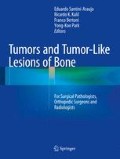Abstract
Osteochondroma is a benign cartilaginous outgrowing neoplasm arising from the surface of the long bone consisting of cartilage-capped bony overgrowth with extension of native bone marrow. It is the most common primary bone tumor. It is approximately 1.5 times more common in male than female. About half the cases occur in the second decade of life. There is predilection for the distal femur, followed by the proximal humerus and proximal tibia. Roentgenograms show a pedunculated or sessile protuberance from the long bone metaphysis. The cortex of the host bone flares out into the osteochondroma cortex. The cartilage cap is covered by a thin periosteal membrane. The limit between the cartilage cap and the underlying cancellous bone shows endochondral ossification, closely mimicking a normal epiphyseal plate. Treatment is surgical excision with the entire cartilage cap.
Access this chapter
Tax calculation will be finalised at checkout
Purchases are for personal use only
Recommended Reading
Bridge JA, Nelson M, Orndal C, et al. Clonal karyotypic abnormalities of the hereditary multiple exostoses chromosomal loci 8q24.1 (EXT1) and 11p11-12(EXT2) in patients with sporadic and hereditary osteochondromas. Cancer. 1998;82:1657–63.
Ciavarella M, Coco M, Baorda F, et al. 20 novel point mutations and one large deletion in EXT1 and EXT2 genes: report of diagnostic screening in a large Italian cohort of patients affected by hereditary multiple exostosis. Gene. 2013;515:339–48.
Jones KB, Piombo V, Searby C, et al. A mouse model of osteochondromagenesis from clonal inactivation of Ext1 in chondrocytes. Proc Natl Acad Sci USA. 2010;107:2054–9.
Mertens F, Rydholm A, Kreicbergs A, et al. Loss of chromosome band 8q24 in sporadic osteocartilaginous exostoses. Genes Chromosom Cancer. 1994;9:8–12.
Reijinders CM, Waaijer CJ, Hamilton A, et al. No haploinsufficiency but loss of heterozygosity for EXT in multiple osteochondromas. Am J Pathol. 2010;177:1946–57.
Zuntini M, Pedrii E, Parra A, et al. Genetic models of osteochondroma onset and neoplastic progression: evidence for mechanisms alternative to EXT genes inactivation. Oncogene. 2010;29:3827–34.
Author information
Authors and Affiliations
Corresponding author
Editor information
Editors and Affiliations
Rights and permissions
Copyright information
© 2015 Springer-Verlag London
About this chapter
Cite this chapter
Park, YK. (2015). Osteochondroma. In: Santini-Araujo, E., Kalil, R., Bertoni, F., Park, YK. (eds) Tumors and Tumor-Like Lesions of Bone. Springer, London. https://doi.org/10.1007/978-1-4471-6578-1_19
Download citation
DOI: https://doi.org/10.1007/978-1-4471-6578-1_19
Publisher Name: Springer, London
Print ISBN: 978-1-4471-6577-4
Online ISBN: 978-1-4471-6578-1
eBook Packages: MedicineMedicine (R0)

